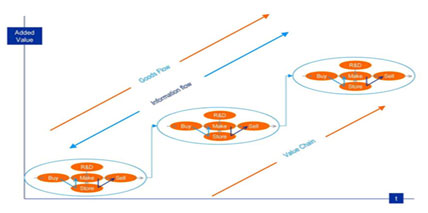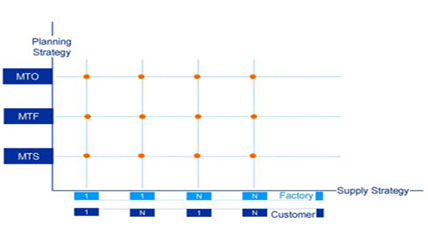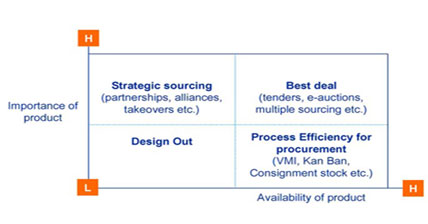Operational Excellence > Supply Chain
A supply chain is a network of facilities and distribution options that performs the functions of procurement of materials, transformation of these materials into intermediate and finished products, and the distribution of these finished products to customers. Supply chains exist in both service and manufacturing organizations, although the complexity of the chain may vary greatly from industry to industry and firm to firm.
We can see below single product's simple supply chain :-Below is an example of a very simple supply chain for a single product, where raw material is procured from vendors, transformed into finished goods in a single step, and then transported to distribution centers, and ultimately, customers. Realistic supply chains have multiple end products with shared components, facilities and capacities. The flow of materials is not always along an arbores cent network, various modes of transportation may be considered, and the bill of materials for the end items may be both deep and large.
Traditionally, marketing, allocation, planning, making, and the purchasing organizations along the supply chain operated independently. These organizations have their own objectives and these are often conflicting. Marketing's objective of high customer service and maximum sales dollars conflict with making n allocating objectives. Many manufacturing operations are designed to maximize throughput and lower costs with little consideration for the impact on inventory levels and distribution capabilities. Purchasing contracts are often negotiated with very little information beyond historical buying patterns. The result of these factors is that there is not a single, integrated plan for the organization---there were as many plans as businesses. Clearly, there is a need for a mechanism through which these different functions can be integrated together. Supply chain management is a strategy through which such accumulation can be achieved.
What Manoj Jagram & Associates Offers
We, at Manoj Jagram & Associates assist in all type decisions making regarding supply chain. These decisions play a very vital role in success of any business. There are four major decision areas in supply chain management: 1) location, 2) production, 3) inventory, and 4) transportation (distribution), and there are both strategic and operational elements in each of these decision areas.
- Location Decisions
- Production Decisions
- Stock Decisions
- Transportation Decisions
We answer lies in aligning the supply chain to the individual needs of your customers, while taking into account the need to maintain a balance between cost and service levels, which can discriminate by industry.
 We are convinced that companies can excel when they understand the specifics of their own business and optimise the flow of goods and information within their supply chain in alignment with those of their suppliers and customers. We understands the changes of these chains and we know that there is not always a single common way for improvement. Using our capabilities and creativity, we will find the practical solution for you.
We are convinced that companies can excel when they understand the specifics of their own business and optimise the flow of goods and information within their supply chain in alignment with those of their suppliers and customers. We understands the changes of these chains and we know that there is not always a single common way for improvement. Using our capabilities and creativity, we will find the practical solution for you.
Main drivers of supply chain characteristics are the levels of differentiation for your customer, product and supply options. Depending on the characteristics of the supply, companies will have to see different kinds of issues in managing in continuing the chain.
Focusing on the supply options, different combinations of supply strategy and planning strategy will be applicable for (parts of) you supply chain. However, to find the optimal supply solution also other variables like warehousing, lead time, forecast ability, type of product, shelf life and working capital have to be taken into account.
 Of course a focus on the internal supply chain is only part of the whole story. Another important area is supplier management. Another important area is supplier management. Approaches and best practices will change according to products and markets. identifying your own position as a supplier for your customers will enable you to focus on the right methods to achieve service improvement.
Of course a focus on the internal supply chain is only part of the whole story. Another important area is supplier management. Another important area is supplier management. Approaches and best practices will change according to products and markets. identifying your own position as a supplier for your customers will enable you to focus on the right methods to achieve service improvement.
The Supply Chain Evolution : In the development of the supply chain we recognise 2 stages and 6 phases: ERP and Business Support tools have been bringing enormous benefits in the internal integration stage, speed and cost. However, the next level of improvement cannot be found solely from within anymore.
 In the next stage, sharing of information dynamics of external supply, the external integration becomes vital in getting the level of external accumulation and collaboration in supply chain.
In the next stage, sharing of information dynamics of external supply, the external integration becomes vital in getting the level of external accumulation and collaboration in supply chain.
This requires a new approach to doing business, adding complication, more communication and sharing of information. Competition does not take place any more in the same supply chain (fighting for margin with the company's suppliers and customers), but between value chains opposing on total value sent

 We are convinced that companies can excel when they understand the specifics of their own business and optimise the flow of goods and information within their supply chain in alignment with those of their suppliers and customers. We understands the changes of these chains and we know that there is not always a single common way for improvement. Using our capabilities and creativity, we will find the practical solution for you.
We are convinced that companies can excel when they understand the specifics of their own business and optimise the flow of goods and information within their supply chain in alignment with those of their suppliers and customers. We understands the changes of these chains and we know that there is not always a single common way for improvement. Using our capabilities and creativity, we will find the practical solution for you. Of course a focus on the internal supply chain is only part of the whole story. Another important area is supplier management. Another important area is supplier management. Approaches and best practices will change according to products and markets. identifying your own position as a supplier for your customers will enable you to focus on the right methods to achieve service improvement.
Of course a focus on the internal supply chain is only part of the whole story. Another important area is supplier management. Another important area is supplier management. Approaches and best practices will change according to products and markets. identifying your own position as a supplier for your customers will enable you to focus on the right methods to achieve service improvement. In the next stage, sharing of information dynamics of external supply, the external integration becomes vital in getting the level of external accumulation and collaboration in supply chain.
In the next stage, sharing of information dynamics of external supply, the external integration becomes vital in getting the level of external accumulation and collaboration in supply chain.